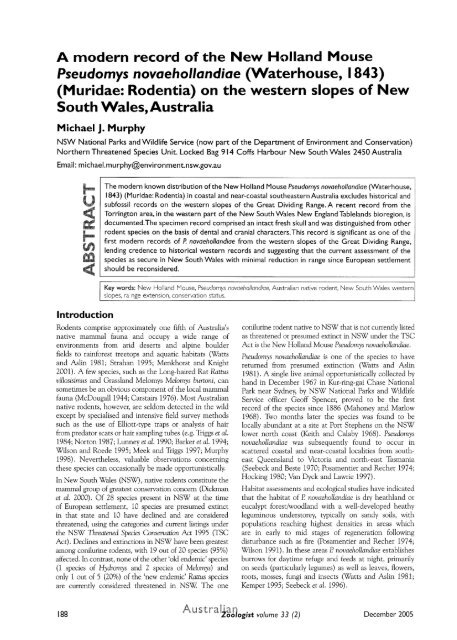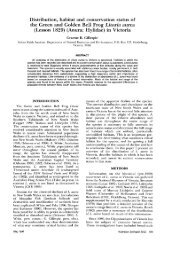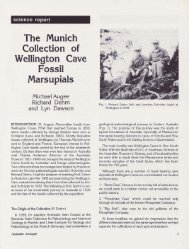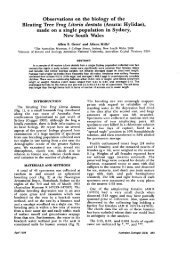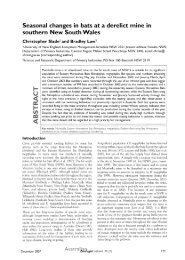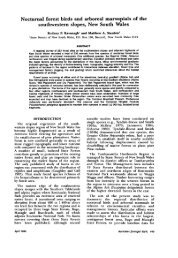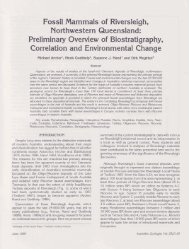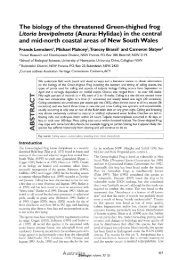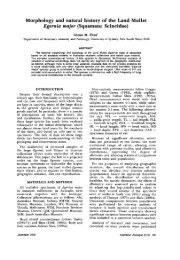Muridae: Rodentia - RZS of NSW
Muridae: Rodentia - RZS of NSW
Muridae: Rodentia - RZS of NSW
Create successful ePaper yourself
Turn your PDF publications into a flip-book with our unique Google optimized e-Paper software.
A modern record <strong>of</strong> the New Holland Mouse<br />
Pseudomys novuehollundiue vaterhouse, 1 843)<br />
(<strong>Muridae</strong>: <strong>Rodentia</strong>) on the western slopes <strong>of</strong> New<br />
South Wales, Australia<br />
Michael J. Murphy<br />
<strong>NSW</strong> National Parks and Wildlife Service (now part <strong>of</strong> the Department <strong>of</strong> Environment and Conservation)<br />
Northern Threatened Species Unit. Locked Bag 9 14 C<strong>of</strong>fs Harbour New South Wales 2450 Australia<br />
The modern known distribution <strong>of</strong> the New Holland Mouse Pseudomys novaehollandiae (Waterhouse,<br />
1843) (<strong>Muridae</strong>: <strong>Rodentia</strong>) in coastal and near-coastal southeastern Australia excludes historical and<br />
subfossil records on the western slopes <strong>of</strong> the Great Dividing Range.A recent record from the<br />
Torrington area, in the western part <strong>of</strong> the New South Wales New England Tablelands bioregion, is<br />
documented.The specimen record comprised an intact fresh skull and was distinguished from other<br />
rodent species on the basis <strong>of</strong> dental and cranial characters-This record is significant as one <strong>of</strong> the<br />
first modern records <strong>of</strong> P novaehollandiae from the western slopes <strong>of</strong> the Great Dividing Range,<br />
lending credence to historical western records and suggesting that the current assessment <strong>of</strong> the<br />
species as secure in New South Wales with minimal reduction in range since European settlement<br />
should be reconsidered.<br />
Key words: New Holland Mouse, Pseudomys novaehollandiae, Australian native rodent, New South Wales western<br />
slopes, ra nge extension, conservation status.<br />
Introduction<br />
Rodents comprise approximately one fifth <strong>of</strong> Australia's conilurine rodent native to <strong>NSW</strong> that is not currently listed<br />
native mammal fauna and occupy a wide range <strong>of</strong> as threatened or presumed extinct in <strong>NSW</strong> under the TSC<br />
environments from arid deserts and alpine boulder Act is the New Holland Mouse Pseudomys novaehollandiae.<br />
fields to rainforest treetops and aquatic habitats (Watts pseudomy, novaehollandiae is one <strong>of</strong> the species to have<br />
and ~slin 1981; ~trahan 1995; Menkhorst and Knight returned from presumed extinction (Watts and Aslin<br />
2001). A few species, such as the Longhaired Rat Rattus 1981). A single live animal opportunistically collected by<br />
villosisirnus and Grassland Melomys Melomys burtoni, can hand in December 1967 in Kur-ringgai Chase National<br />
sometimes be an obvious component <strong>of</strong> the local mammal Park near Sydney, by <strong>NSW</strong> National Parks and Wildlife<br />
fauna (McDougall 1944; Carstairs 1976). Most Australian Service <strong>of</strong>ficer Ge<strong>of</strong>f Spencer, proved to be the first<br />
native rodents, however, are seldom detected in the wild record <strong>of</strong> the s~eciesince 1886 (Mahonev and Marlow<br />
L<br />
except by specialised and intensive field survey methods 1968). Two months later the species was found to be<br />
such as the use <strong>of</strong> Elliott-type traps or analysis <strong>of</strong> hair locally abundant at a site at Port Stephens on the <strong>NSW</strong><br />
from predator scats or hair sampling tubes (e.g. Triggs et al. lower north coast (Keith and Calaby 1968). Pseudomys<br />
1984; Norton 1987; Lunney et al. 1990; Barker et al. 1994; novaehollandiae was subsequently found to occur in<br />
Wilson and Roede 1995; Meek and Triggs 1997; Murphy scattered coastal and near-coastal localities from south-<br />
1998). Nevertheless, valuable observations concerning east Queensland to Victoria and north-east Tasmania<br />
these species can occasionally be made opportunistically. (Seebeck and Beste 1970; Posamentier and Recher 1974;<br />
Hocking 1980; Van Dyck and Lawrie 1997).<br />
In New South Wales (<strong>NSW</strong>), native rodents constitute the<br />
mammal group <strong>of</strong> greatest conservation concern (Dickman<br />
et al. 2000). Of 28 species present in <strong>NSW</strong> at the time<br />
<strong>of</strong> European settlement, 10 species are presumed extinct<br />
in that state and 10 have declined and are considered<br />
threatened, using the categories and current listings under<br />
the <strong>NSW</strong> Threatened Species Conservation Act 1995 (TSC<br />
Act). Declines and extinctions in <strong>NSW</strong> have been greatest<br />
among conilurine rodents, with 19 out <strong>of</strong> 20 species (95%)<br />
affected. In contrast, none <strong>of</strong> the other 'old endemic' species<br />
(1 species <strong>of</strong> Hydrornys and 2 species <strong>of</strong> Mehys) and<br />
only 1 out <strong>of</strong> 5 (20%) <strong>of</strong> the 'new endemic' Rattus species<br />
are currently considered threatened in <strong>NSW</strong> The one<br />
Habitat assessments and ecological studies have indicated<br />
that the habitat <strong>of</strong> P novaehollandiae is dry heathland or<br />
eucalypt forest/woodland with a well-developed heathy<br />
leguminous understorey, typically on sandy soils, with<br />
populations reaching highest densities in areas which<br />
are in early to mid stages <strong>of</strong> regeneration following<br />
disturbance such as fire (Posamentier and Recher 1974;<br />
Wilson 1991). In these areas I? novaehollandiae establishes<br />
burrows for daytime refuge and feeds at night, primarily<br />
on seeds (particularly legumes) as well as leaves, flowers,<br />
roots, mosses, fungi and insects (Watts and Aslin 1981;<br />
Kemper 1995; Seebeck et al. 1996).<br />
ogist volume 33 (2) December 2005
A modern record <strong>of</strong> the New Holland Mouse<br />
Until recently, the modern known distribution <strong>of</strong> I?<br />
novaehollandiae excluded historical records west <strong>of</strong> the<br />
Great Dividing Range (Kemper 1977; Watts and Aslin<br />
1981; Menkhorst and Knight 2001). The species was<br />
originally described from specimens collected near Scone<br />
in the upper Hunter Valley, <strong>NSW</strong> (Waterhouse 1843).<br />
Gould (1863) described the species as occurring on plains<br />
and stony ridges on both sides <strong>of</strong> the Great Dividing<br />
Range in northern <strong>NSW</strong>. Fossil and subfossil records are<br />
also known from several localities on the western slopes <strong>of</strong><br />
central and southern <strong>NSW</strong>) including near Orange, Yass<br />
and Yarrangobilly (Kemper 19 7 7). The slopes and plains<br />
<strong>of</strong> <strong>NSW</strong> west <strong>of</strong> the ranges have undergone extensive<br />
land clearing and modification since European settlement<br />
to become a major pastoral and agricultural region,<br />
coinciding with a significant reduction in the regional<br />
diversity <strong>of</strong> native vertebrate fauna species (Barrett et<br />
al. 1994; Paul1 and Date 1999). Watts and Aslin (1981)<br />
suggested that P novaehollandiae may have been among<br />
the suite <strong>of</strong> native species lost from the western slopes.<br />
This paper reports on a fortuitous recent record <strong>of</strong> I?<br />
novaehollandiae from the western part <strong>of</strong> the New England<br />
Tablelands bioregion, on the upper western slopes <strong>of</strong> the Great<br />
Dividing Range in northern <strong>NSW</strong> This record is significant<br />
as one <strong>of</strong> the first modem records fiom the western, inland<br />
portion <strong>of</strong> the species' historical distribution.<br />
Collection and Locality details<br />
A single mouse-size rodent skull was noted and collected<br />
from the surface <strong>of</strong> an ant nest in dry open forest in the<br />
Torrington area north-west <strong>of</strong> Glen Innes during the<br />
course <strong>of</strong> a herpet<strong>of</strong>auna survey in March 1997. The skull<br />
(Fig. 1) was identified as that <strong>of</strong> a Pseudomys species on<br />
the basis <strong>of</strong> size and the absence <strong>of</strong> the notch in the upper<br />
incisors diagnostic <strong>of</strong> the House Mouse Mus musculus<br />
(Watts and Aslin 1981). The specimen was lodged in<br />
the Australian Museum (AM specimen M33380), where<br />
closer examination identified it as I! novaehollandiae<br />
(S. Ingleby Aust. Museum pers. comm. 1997). The<br />
specimen was re-examined in 2004 and identification as<br />
I? novaehollandiae confirmed (E Ford CSIRO pers. comm.<br />
2004). Ford (pers. comm. 2004) provided the following<br />
comments on identification:<br />
The skull possesses dental and cranial characters<br />
typical <strong>of</strong> P novaehollandiae, such as bulbous<br />
anteriolabial cusps on the MI, and broad zygomatic<br />
plate. The bullae are significantly smaller than<br />
those <strong>of</strong> Pseudomys patrius, and the MI lacks<br />
an accessory cusp typical <strong>of</strong> both P patrius and<br />
Pseudomys delicatulus. The molar row, particularly<br />
the MI, is less elongate than both those species.<br />
The skull is larger than those <strong>of</strong> I? delicatulus, and<br />
is almost identical to an Australian Museum I!<br />
novaehollandiae voucher from the Apsley Falls area.<br />
Pseudomys pilligaensis is morphologically analogous<br />
to I? delicatulus, and is almost certainly a junior<br />
synonym <strong>of</strong> that species on the basis <strong>of</strong> genetic<br />
and morphological characters, and the Torrington<br />
specimen is clearly not that "species".-<br />
The collection site (151" 36' E, 29" 20' S) (Fig. 2) was<br />
located on a low rocky ridge north <strong>of</strong> the Beardy River,<br />
just outside the southern boundary <strong>of</strong> Torrington State<br />
Recreation Area and approximately 12 km north <strong>of</strong> the<br />
village <strong>of</strong> Emmaville. The Beardy River is within the<br />
Figure I: Skull <strong>of</strong> New Holland Mouse (Australian Museum specimen M33380) collected near Torrington in 1997.<br />
This opportunistically collected specimen lends credence to statements by John Gould and john Gilbert that the<br />
distribution <strong>of</strong> the New Holland Mouse in the 1 9th Century extended to the western slopes, and suggests that the<br />
current assessment <strong>of</strong>the species as secure in <strong>NSW</strong> with minimal reduction in range since European settlement should<br />
be reconsidered. Photograph courtesy <strong>of</strong> Fred Ford.<br />
December 2005 A str a bologist volume 33 (2)
Murphy<br />
Figure 2: Modern records <strong>of</strong>the New Holland Mouse in northern New South Wales-The record in theTorrington area<br />
is significant as the only one west <strong>of</strong> the Great Dividing Range watershed. Source: DEC Atlas <strong>of</strong> <strong>NSW</strong> Wildlife database.<br />
Bioregional boundaries followThackway and Creswell ( 1 995).<br />
McIntyre River catchment area in the north-east part <strong>of</strong> The vegetation at the site was dry low open eucalypt forest<br />
the Murray-Darling basin. The site was at an elevation <strong>of</strong> dominated by Eucalyptus dealbata and an unidentified<br />
820 m AHD, with a 10 " slope and westerly aspect, and Stringybark Eucalyptus sp. Eucalyptus melliodora, Eucalyptus<br />
was approximately 170 km from the coast on the upper praa, Callitris endlichen and Angophora flonbunda were<br />
western slopes <strong>of</strong> the Great Dividing Range.<br />
also present. Tree height was between 12 and 20 m and<br />
1 90 ogist volume 33 (2) December 2005
A modern record <strong>of</strong> the New Holland Mouse<br />
tree DBH (diameter at breast height) was between 10<br />
and 30 cm. Canopy cover was approximately 55%. A<br />
well-defined shrub layer dominated by Olearia elliptica<br />
was present. Other shrubs present included Cassinia<br />
quienquefaria, Melichrus urseleolatus, Acacia nerrifolia and<br />
Acacia cheelii. The ground cover comprised tussock grasses<br />
and herbs (about 45% <strong>of</strong> ground surface), scattered rocks<br />
and fallen timber (40%) and leaf litter (15%). The<br />
substratum was a sandy soil derived from granite <strong>of</strong> the<br />
Mole Granite formation.<br />
Discussion<br />
The occurrence <strong>of</strong> Pseudomys novaeholhndiae on the upper<br />
western slopes <strong>of</strong> the Great Dividing Range reported here<br />
indicates a western extension <strong>of</strong> the species' known modem<br />
range. Menkhorst and Knight (2001) described the species<br />
as occurring up to 100 km inland and at elevations up to<br />
600 m AHD in northeast <strong>NSW</strong> and southeast Queensland.<br />
The present record extends this by another 70 krn inland<br />
and 220 m elevation, Other modem records <strong>of</strong> the species<br />
in the New England Tablelands bioregion (Fig. 2), whilst<br />
relatively close, are all located along the eastern escarpment<br />
within coastal river catchments. The last record <strong>of</strong> I?<br />
novaehollandiae on the western side <strong>of</strong> the Great Divide in<br />
northern <strong>NSW</strong> was by John Gould's collector John Gilbert,<br />
who recorded it as abundant near the Gwydir kver in the<br />
1840s (Gould 1863).<br />
Troughton (1957)) conjectured that the absence <strong>of</strong> modem<br />
records <strong>of</strong> I? novaeholladiae might be due to confusion with<br />
the introduced Mus musculus, urged readers east or west<br />
<strong>of</strong> the Great Dividing Range to forward specimens to the<br />
Australian Museum, Following the subsequent rediscovery<br />
<strong>of</strong> the species in coastal areas, Mahoney and Marlow<br />
(1968) voiced doubt over the accuracy <strong>of</strong> Gdbert's western<br />
records, noting that no P novaehollandiae specimens from the<br />
Gwydir River area could be found in Museum collections<br />
and further noting early confusion and misidentification<br />
between I? novaehollandiae and other species such as the<br />
Sandy Inland Mouse Pseudomys hermannsburgensis and<br />
Gould's Mouse Pseudomys gou2di. Posamentier and Recher<br />
(1974) made no mention <strong>of</strong> historical western records in<br />
describing the status and distribution <strong>of</strong> I? novaeholhndiae.<br />
Watts and Aslin (198 1) noted that the modem conception<br />
<strong>of</strong> the species' distribution and habitat differed from that<br />
<strong>of</strong> Gould (1863)) and suggested that either the historical<br />
western records may have been due to confusion with M.<br />
musculus, or that the species may have since disappeared<br />
fiom its western distribution as a result <strong>of</strong> habitat changes<br />
caused by pastoral development. Fossil and subfossil<br />
records (summarised by Kemper (1 97 7)) confirm that<br />
the distribution <strong>of</strong> I? nouaeholhndiae did indeed extend to<br />
the western slopes <strong>of</strong> <strong>NSW</strong> in pre-European times. The<br />
Torrington record reported here further supports Gould's<br />
(1863) statements concerning the continued occun-ence <strong>of</strong><br />
the species on the western slopes into the 19t11 Century.<br />
Further substantiation <strong>of</strong> the western slopes occurrence<br />
<strong>of</strong> I? nouaehollandiae was provided by the recent discovery<br />
<strong>of</strong> the species in Goobang National Park, about 20 km<br />
east <strong>of</strong> Parkes in the northern part <strong>of</strong> the <strong>NSW</strong> South<br />
Western Slopes bioregion (Faulkner et al. 1997). Ford<br />
(pers. comm. 2004) confirmed the identification <strong>of</strong> the<br />
Goobang specimens as I? nouaehollandiae. Specimens were<br />
captured in Elliott-type traps in open forest with a closed<br />
heath understorey at a number <strong>of</strong> different sites in the<br />
park in MarchIApril 1997 (W. Faulkner <strong>NSW</strong> DEC pers.<br />
comm. 2002).<br />
Comparison <strong>of</strong> the Torrington I? novaehollandiae site<br />
with modern coastal and near coastal habitats <strong>of</strong> the<br />
species indicates broad similarities. In common with<br />
the descriptions <strong>of</strong> preferred coastal habitat (Keith and<br />
Calaby 1968; Posamentier and Recher 1974; Wilson<br />
1991; Kemper 1995), the Torrington site had a sandy soil<br />
substratum supporting a well-developed shrub or heathy<br />
layer under an open forest overstorey. Leguminous flora<br />
species recorded at the Torrington site include Acacia<br />
nerrifolia and A. cheelii. A diverse range <strong>of</strong> leguminous<br />
flora species has been recorded in the nearby Torrington<br />
State Recreation Area. The description <strong>of</strong> the Goobang<br />
I? novaehollandiae sites as open forest with a heath<br />
understorey is similarly consistent with descriptions <strong>of</strong><br />
coastal habitats for the species.<br />
Lee (1995) assessed the national conservation status <strong>of</strong><br />
I? novaehollandiae as secure, with a national decline in<br />
distribution estimated as less than 10%. Nevertheless, the<br />
species is considered to be <strong>of</strong> conservation concern in both<br />
Victoria and Tasmania. It is currently listed as endangered<br />
in the Victorian Flora and Fauna Guarantee Act 1988, on<br />
the basis <strong>of</strong> rarity and demonstrable decline (Seebeck et<br />
al. 1996)) and as endangered in the Tasmanian Threatened<br />
Species Protection Act 1995, on the basis <strong>of</strong> rarity and<br />
unprotected habitat (DPIWE 2004). The status <strong>of</strong> the<br />
species in <strong>NSW</strong> was regarded by Dickman et al, (2000)<br />
as secure. However, the confirmation <strong>of</strong> the species'<br />
historical and modern occurrence on the western slopes<br />
<strong>of</strong> <strong>NSW</strong> indicates that its conservation status in <strong>NSW</strong><br />
should perhaps be reconsidered.<br />
The western slopes bioregions <strong>of</strong> <strong>NSW</strong> are among the<br />
most extensively modified areas in Australia. In the<br />
New England Tablelands bioregion, 74% <strong>of</strong> the original<br />
vegetation has been cleared since European settlement,<br />
45% <strong>of</strong> the bioregion is devoted to intensive agricultural<br />
or pastoral production and only 2% <strong>of</strong> the bioregion<br />
has been set aside for conservation purposes, while<br />
the corresponding figures for the <strong>NSW</strong> South Western<br />
Slopes bioregion are even more dire, with 80% cleared,<br />
55% under intensive production and 1% conserved<br />
(State <strong>of</strong> the Environment Advisory Council 1996). For<br />
comparison, in the <strong>NSW</strong> North Coast bioregion, which<br />
supports the greatest number <strong>of</strong> known populations <strong>of</strong><br />
I? novaeholhndiae in NSY 37% <strong>of</strong> the bioregion has<br />
been cleared, 21% is under intensive production and<br />
8% is conserved (State <strong>of</strong> the Environment Advisory<br />
Council 1996). Given the extent <strong>of</strong> habitat clearing and<br />
fragmentation and the general scarcity <strong>of</strong> native rodents<br />
in the western slopes bioregions in <strong>NSW</strong>, surviving<br />
western populations <strong>of</strong> I-! novaehollandiae should be<br />
considered to be <strong>of</strong> conservation concern, and may<br />
warrant listing as endangered populations at a bioregional<br />
scale under the TSC Act. Managers <strong>of</strong> western slopes<br />
conservation reserves, state forests, crown reserves and<br />
December 2005 ogist volume 33 (2)
Murphy<br />
other public lands known or considered likely to support<br />
P novaehollandiae should consider conservation actions<br />
including field surveys to determine presence <strong>of</strong> the<br />
species, population and habitat monitoring, vouchers<br />
and tissue sampling for taxonomic studies, control <strong>of</strong> feral<br />
predators in key areas, and fire management strategies<br />
appropriate to the ecological requirements <strong>of</strong> the species.<br />
The record <strong>of</strong> P novaehollandiae documented in this paper,<br />
like the first modem record <strong>of</strong> the species in 1967, was the<br />
result <strong>of</strong> acting on a fortuitous opportunity. Both records<br />
demonstrate the value <strong>of</strong> critical observation in the field<br />
and the importance <strong>of</strong> supporting significant observations<br />
with voucher specimens lodged - in Museum collections, The<br />
status <strong>of</strong> P novaehollandm on the western slopes <strong>of</strong> northern<br />
<strong>NSW</strong> remains largely unknown. Further investigation <strong>of</strong> the<br />
Torrington locality and other areas with potential habitat is<br />
~rgently needed. In the interim, a precautionaq approach<br />
should be taken, with western populations <strong>of</strong> the species<br />
afforded consideration and protection as bioregionally<br />
signdicant and at risk <strong>of</strong> extinction.<br />
Acknowledgements<br />
Thanks to Fred Ford, Sandy Ingleby and Alex Baynes for<br />
assistance confirming idendcation <strong>of</strong> the I! mmhollandiae<br />
specimen, PM Spark for providing a description <strong>of</strong> vegetation<br />
at the Torrington collection site, Bd Faulkner and Murray Ellis<br />
for information concerning the Goobang I! novuehollandiae<br />
records, Jill Smith for assistance preparing Figure 2, and Dan<br />
Lunney, Fred Ford, Catherine Kemper and an anonymous<br />
referee for comments on the original manuscript. The author<br />
would also lke to acknowledge the credit owed to Ge<strong>of</strong>f<br />
Spencer's initial interest in small rodents.<br />
References<br />
Barker, J., Lunney, D. and Bubela, T. 1994. Mammal surveys Lunney, D., Triggs, B., Eby, ]P. and Ashby, E. 1990. Analysis<br />
in the forests <strong>of</strong> the Carrai Plateau and fichmond Range - in <strong>of</strong> scats <strong>of</strong> dogs Canis familiaris and foxes Vulpes vulpes (Canidae:<br />
north-east New South Wales. Australian Mammalogy 17: 19/29. Carnivora) in coastal forests near Bega, New South Wales.<br />
Australian Wildlife Research 17: 61-68.<br />
Barrett, G. W., Ford, H. A. and Recher, H. E 1994.<br />
Conservation <strong>of</strong> woodland birds in a fragmented rural landscape. Mahoney, J. A+ and Marlow, B. J. 1968. The red is cove^ in New<br />
Pacific Conservation Biology -- 1 : 245-56.<br />
South Wales (Kur-ring-gai Chase National Park and Port Stephens)<br />
<strong>of</strong> Pseudomys novaeholladiae (Waterhouse, 1843) (~odentia:<br />
Carstairs, J. L. 1976. Population dynamics and movement<br />
<strong>Muridae</strong>) . Australian Journal <strong>of</strong> Science 31 (6): 221-23.<br />
<strong>of</strong> Rattus villosissimus (Waite) during the 1966-69 plague<br />
<strong>of</strong> Brunette Downs, Northern ~erritory. Australian wildlife McDougall, Wl A. 1944. An investigation <strong>of</strong> the rat pest<br />
Research 3:l-10.<br />
problem in Queensland canefields: 2. Species and general habits.<br />
Queensland Journal <strong>of</strong> Agricultural Science 1 : 48-78<br />
Department <strong>of</strong> Primary Industries, Water and Environment<br />
2004. Parks and Wildlife website www.dpiwe.tas.gov.au/Parks & Meek, I? D. and Trig@, B. 1997. Extension to the range <strong>of</strong> the<br />
Wildlifenhreatened Speciesnhreatened Species Education Kit/ Eastern Chestnut Mouse, Pseudom~s gracilicaudatus, to Jervis Bay,<br />
Threatened Species-MammalsNew Holland Mouse. Updated New South 'Wales- Australian Mammalo# 20: 123-25.<br />
11 May 2004. Menkhorst, E and Knight, E 2001. A Field Guide to the Mammals<br />
Dickman, C. R., Lunney, D. and Matthews, A. 2000. <strong>of</strong> Australia. Oxford University Press. Melbourne Victoria.<br />
Ecological attributes and conservation <strong>of</strong> native rodents in New ~~~~h~ M. J. 1998. ~~~~~l <strong>of</strong> seven ~ i~~~~h<br />
l ~<br />
South Wales. Wildlife Research 27: 347-55.<br />
National Park and Comerong Island Nature Reserve on the south<br />
Faulkner, W., Le Breton, M. and Ellis, M. 1997. Fauna survey coast <strong>of</strong> New South KVales. ~Iustrahn aoh!jst 30: 419-25.<br />
<strong>of</strong> Goobang and Nangar National Park. <strong>NSW</strong> National parks and Norton, T. W. 1987. The effect <strong>of</strong> trap placement on trapping<br />
Wildlife Service internal report. NPWS, Hurstville <strong>NSW</strong>. success <strong>of</strong> Rattus lutreolus velutinus (Thomas) (<strong>Muridae</strong>:<br />
Gould, J. 1863, The Mammals <strong>of</strong> Australia. Val. 111. The author, <strong>Rodentia</strong>) in north-east Tasmania. Australian Wildlife Research<br />
London. 14: 305-10.<br />
Hocking, G. J. 1980. The occurrence <strong>of</strong> the New Holland Paull, D. C. and Date, E. M. 1999. Patterns <strong>of</strong> decline in the<br />
Mouse Pseudomys novaehollandiae (Waterhouse) in Tasmania. native mammal fauna <strong>of</strong> the north-west slopes <strong>of</strong> New South<br />
Australian Wildlife Research 7: 71-77. Wales. Australian Zoologist 31 : 210-24.<br />
Keith, K. and Calaby, J. H. 1968. The New Holland Mouse Posamentier, H. and Recher, E 1974. The status <strong>of</strong><br />
Pseudomys novaehollandiae (Waterhouse) in the Port Stephens Pseudomys n~wzhollandiae (the New Holland Mouse). A~stralian<br />
District, New South Wales. CSIRO Wildlife Research 13: 45-58. Zoologist 18(2): 66-71.<br />
Seebeck, J. H. and Beste, H. J. 1970. First record <strong>of</strong> the New<br />
Kemper, C. 1977. The Biology <strong>of</strong> the New Holland Mouse<br />
Pseudomys novaehollandiae (Waterhouse, 1843). PhD Thesis, I3olland Mouse f'seudomys novaehollandiae (Waterhouse, 1843)<br />
Macquarie University, <strong>NSW</strong> in Victoria. Victorian Naturalist 87: 280-87.<br />
Kemper, C. 1995. New Holland Mouse. Pp. 611-12 in The Seebeck, J* He, Menkhorst, P.7 Wilson, Be and Lowe,<br />
Mammals <strong>of</strong> Australia, edited by R. Strahan. Reed Books, 1996, New Eblland Mouse Pseudom~s novaehollandiae.<br />
Chatswood, <strong>NSW</strong><br />
Action Statement No. 74. Department <strong>of</strong> Natural Resources and<br />
Environment, Victoria. 8 pp.<br />
Lee, A. K. 1995. The Action Plan for Australian Rodents.<br />
Australian Nature Conservation Agency Endangered Species State <strong>of</strong> the Environment Advisory Council. 1996.<br />
Program Project Number 130, Australian Nature Conservation Australian State <strong>of</strong> the Environment 1996. Publishing,<br />
Agency Canberra ACT.<br />
Collingwood, Victoria.<br />
1 92 A'stra%gogirt volume 33 (2) December 2005
A modern record <strong>of</strong> the New Holland Mouse<br />
Strahan, R. (ed.) 1995. The Mammals <strong>of</strong> Australia. Reed Books,<br />
Chatswood, <strong>NSW</strong>.<br />
Thackway, R. and Creswell, I. D. 1995 (eds.) An Interim<br />
Biogeographic Regionalisation for Australia: a Framework for<br />
Establishing the National System <strong>of</strong> Reserves, Version 4.0. Australian<br />
Nature Conservation Agency, Canberra. 88 pp.<br />
Triggs, B., Brunner, H. and Cullen, J. M. 1984. The food <strong>of</strong><br />
fox, dog and cat in Croajingalong National Park, south-eastern<br />
Victoria. Australian Wildlife Research 1 1: 491-99.<br />
Troughton, E. 1957. Furred Animals <strong>of</strong> Australia (6th edition).<br />
Angus and Robertson, Australia. 376 pp.<br />
Van Dyck, S. and Lawrie, B. 1997. The New Holland Mouse<br />
Pseudomys novaehollandiae (<strong>Rodentia</strong>: <strong>Muridae</strong>) , an addition to<br />
the mammal fauna <strong>of</strong> Queensland. Memoirs <strong>of</strong> the Queensland<br />
Museum 42(1): 367-76.<br />
Waterhouse, G. R. 1843, Description <strong>of</strong> two new species <strong>of</strong> the<br />
genus Mus. Proc. 2001. Soc. Lond. 1842: 145-6.<br />
Watts, C. H. S. and Aslin, H. J. 1981. The Rodents <strong>of</strong> Australia.<br />
Angus and Robertson, Australia. 321 pp.<br />
Wilson, B. A. 1991. The ecology <strong>of</strong> Pseudomys novaehol2andiae<br />
(Waterhouse, 1843) in the eastern Otway Ranges, Victoria.<br />
Wildlife Research 18: 233-47.<br />
Wilson, B. A. and Roede, R. 1995. Identification <strong>of</strong> New<br />
Holland Mouse, Pseudomys novaehollandiae, populations using<br />
hair sampling tubes. Australian Mammalogy 20: 135-38.<br />
December 2005 ogist volume 33 (2)


